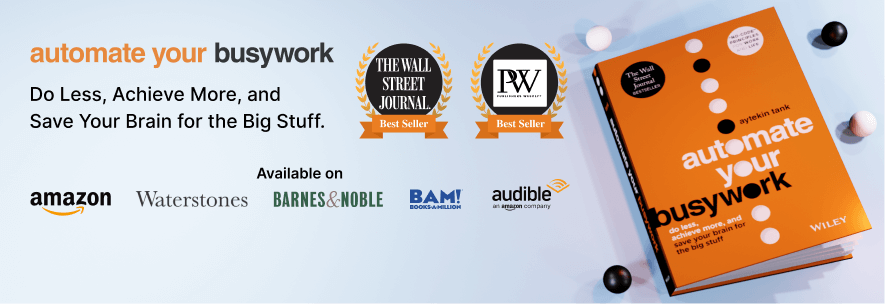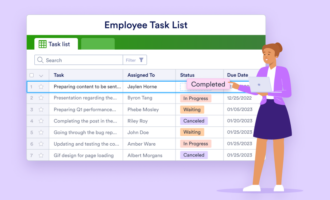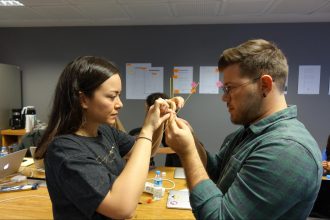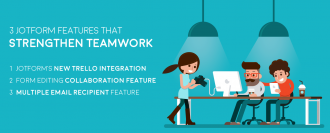If you’ve tasted a pint of Ben & Jerry’s ice cream, then I’m sure you’ll agree: collaborations can be delicious. And highly profitable.
In 2000, founders and fellow bootstrappers Ben Cohen and Jerry Greenfield sold their unconventional ice cream company to Unilever for $326 million.
Apparently, Cohen and Greenfield were a match made in frozen dessert heaven.
While Cohen, a savvy entrepreneur, focused on the business and marketing, Greenfield, a thoughtful introvert, dedicated himself to making incredible ice cream.
Cohen explained to The New York Times in 1994:
“As a manager, I’m fairly autocratic. I’m hard to please, not very communicative. People perceive me as intimidating. I tend to be more conceptual and Jerry tends to be more practical. I tend to be more independent and Jerry is better with people. I am not able to do routine things. Jerry is.”
Pooling their complementary skill sets, the duo turned a small-town scoop shop (and an initial investment of $12,000) into an internationally-known ice cream brand. Not to mention, the world is a better place thanks to Chunky Monkey.
At its best, collaboration can be hugely beneficial to an organization. Employees can share resources, swap perspectives, and boost each other’s creativity.
At its worst, however, there are serious drawbacks. Collaborations can be unproductive, time-wasting, and a strain on top employees. These are just a few of the complaints I’ve heard. It’s reached a point where many people are wary of collaborating.
In a recent study of a Fortune 500 technology company, 60% of employees said they wanted to spend less time responding to collaboration requests.
Collaboration is a linchpin of product development at my company, Jotform. Our employees work in cross-functional teams with different roles, backgrounds, and expertise. And I’ve seen firsthand how projects benefit from their collective efforts.
But left unchecked, any collaboration can drain more resources than it’s worth. With that dichotomy in mind, I’ve developed a short guide to maximizing team efforts and eliminating unproductive collaboration.
Before we dive in, a quick reminder of what companies can gain from the right kind of collaboration.
The benefits of workplace collaboration
The Financial Times surveyed 70 leading employers from around the world to learn what managers want from MBA graduates. Three of the five most in-demand skills were: the ability to work in a team, to work with a wide variety of people, and to build, sustain, and expand a network of people.
Why are these such highly coveted skills?
Because the entire organization stands to profit from the collaborative abilities of its people.
According to a whitepaper from UNC Kenan-Flagler Business School, the benefits of organization-wide collaboration include increased energy, creativity, and productivity, which leads to happier, less stressed, and more engaged employees.
By now, we all know the advantages of boosting employee engagement: a competitive advantage when attracting top talent, increased revenue and profitability, and more satisfied customers.
The authors also highlight how collaboration can help organizations to develop and bring products to market faster. At my company Jotform (where our competitors include tech titans like Google), this last benefit is a potential game-changer — a slingshot in our David versus Goliath scenario.
Collaboration allows us to capitalize on the collective knowledge and expertise of our people, while breaking down intra-company silos.
In the past, companies functioned well when employees focused on their individual, discrete tasks. Think Henry Ford and his revolutionary assembly line model.
But in today’s knowledge economy, sharing information and insight is crucial.
I thought about this during a recent demo day, as I watched one of our teams hash out the early stages of a product idea. When a lead designer, developers, UX specialists, and data scientists combine forces, the results are powerful. They develop more innovative, well-thought-out ideas — at least nine times out of 10.
I can’t imagine trying to achieve the same level of creative output any other way. That said, left unchecked, collaboration has the potential to run awry.
Some downsides of collaboration
Collaboration can be a double-edged sword. Rob Cross, a professor of global leadership at Babson College and a Harvard Business Review contributor, agrees.
While acknowledging the positive benefits, Cross says that a collaborative organizational structure can drain people’s time and resources, wherein employees are “emailed to death and meetinged to death.”
In fact, at many companies, people spend a whopping 80 percent of their time in meetings, on the phone, and responding to emails.
That leaves little time for truly valuable work that requires deep focus.
What’s worse, top employees often feel this crunch most acutely.
It’s a phenomenon that University of Oklahoma professor Mark Bolino calls “escalating citizenship.” Over time, the best collaborators face increasing demands. Eventually, they become bottlenecks and work doesn’t progress without their sign-off.
If alarm bells aren’t already sounding, consider this: researchers have found that top collaborators score lowest on engagement and career satisfaction.
Eventually, these employees are so overburdened that they become ineffective. Plus, they have little time left for the tasks they find most rewarding.
How to eliminate unnecessary (and foster effective) collaboration
While we should all encourage a collaborative work culture, it’s important to establish some ground rules. That way, we can reap the full benefits of collaboration and still leave time for focused, individual work.
Before you send an email or request a meeting, start with a gut check: can I get this done on my own? If it requires just a little extra digging, then doing it yourself will save you and your colleagues valuable time.
I like this piece of advice from Lisa Bodell, CEO of Future Think:
“Encourage employees to work smarter — not harder — by collectively rewarding teams that reduce unnecessary processes, reports, or paperwork.”
For managers, it’s important to communicate this time-saving goal to employees. And make it easier for people to act autonomously by encouraging all staff to leverage resource-sharing technologies like Slack and Salesforce.com’s Chatter.
Also, give employees the green light to delegate and redirect collaboration requests when they feel it’s appropriate.
Rob Cross explains that the most effective collaborators know when to shift decisions away from themselves: “They create alternative go-to people so the things they were good at five years ago aren’t tracking with them over time.”
Managers can also re-shuffle responsibilities by eliminating unnecessary sign-offs, and encouraging employees to make calls on their own. This helps to prevent managers and “escalated citizens” from becoming bottlenecks.
Jotform employees know: I’m all about fast decisions. Even if that means an occasional bad call, I encourage them not to waste time deliberating. We can learn from any mistakes later.
Another vital but often overlooked step is to regularly reinforce your organization’s vision and purpose. That way, your teams know everyone is working toward the same goal and will cultivate more helpful, willing attitudes.
Elon Musk captured this notion perfectly in an email to Tesla employees:
“How can it possibly help Tesla for [departments] to erect barriers between themselves or see their success as relative within the company instead of collective? We are all in the same boat. Always view yourself as working for the good of the company and never your dept.”
For effective collaboration (or delegation), it helps to know where everyone’s expertise lies. Make sure your employees get to know each other, whether that happens through group lunches, coffee breaks, or informal social events. This also builds trust — a vital element for successful collaboration.
Uchechi Kalu Jacobson, founder of Linking Arts Web Design & Development, shared why he prioritizes relationship-building:
“I run a software development company, and I often bring in new members to the team. Although we don’t all know each other, telling our stories allows us to understand each person’s ‘why.’ When we share these stories, we are able to have more empathy for the other person and understand their journey. I find this really powerful, especially in the world of web design and development.”
And don’t forget to reward effective collaborators. To do so, experts recommend using tools such as network analysis, peer recognition programs, and value-added performance metrics.
Finding the collaborative sweet spot
Collaboration can be sweet — like a pint of Ben & Jerry’s Cookie Dough ice cream. But when it goes sour, it can become a burden and threaten the wellbeing of our most talented employees.
Sometimes it’s tricky to strike a balance between encouraging smart collaboration and eliminating excessive teamwork.
Hopefully, with some extra effort from managers and team members alike, we can foster effective collaboration and leave employees the time they need for high-value deep work.
As Cal Newport points out:
“As we shift to an information economy, more and more of our population are knowledge workers, and deep work is becoming a key currency… Our ability to do deep work is becoming increasingly rare at exactly the same time it is becoming increasingly valuable.”





























Send Comment:
1 Comments:
More than a year ago
very nice, i really like your blog Thanks & Regards,
From Call Center Software.